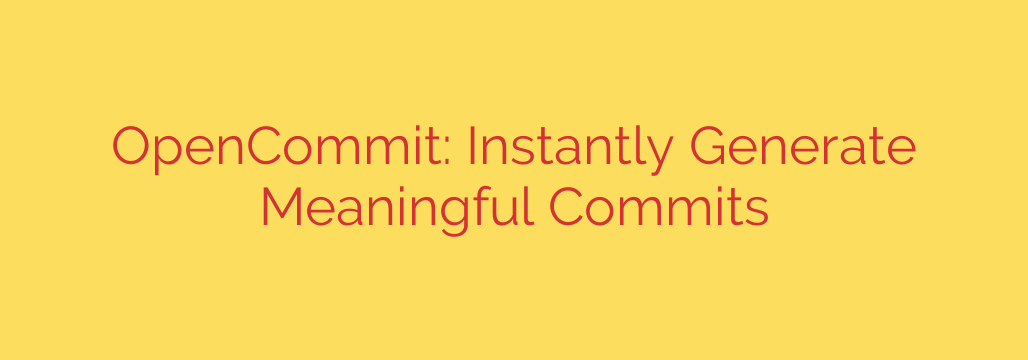
Automate Your Commit Messages with AI: A Guide to Smarter Version Control
Every developer knows the feeling. You’ve just finished a complex task, debugged a tricky issue, or refactored a major component. Now, all that stands between you and moving on is a simple git commit. But what do you write? Crafting a meaningful, concise, and useful commit message can feel like a chore, leading to lazy habits and a history littered with "fix bug", "update", or "wip".
A poorly documented version history is more than just an annoyance; it’s a technical debt that makes code reviews harder, onboarding new team members a nightmare, and debugging past changes nearly impossible. But what if you could automate this process, generating perfectly formatted and descriptive commit messages in seconds?
This is no longer a futuristic dream. With the rise of accessible AI, powerful tools are emerging that can instantly analyze your code changes and write meaningful commit messages for you, transforming your entire development workflow.
The Problem with Vague Commit Messages
Before diving into the solution, it’s crucial to understand the problem. A Git repository’s history is a story. It tells you why changes were made, not just what changed. When that story is filled with vague or unhelpful entries, your team loses critical context.
This leads to several issues:
- Inefficient Code Reviews: Reviewers have to spend extra time deciphering the purpose of a pull request.
- Difficult Debugging: When a bug is introduced,
git bisectbecomes far less effective if you can’t tell what each commit was intended to do. - Slow Onboarding: New developers can’t rely on the commit history to understand the evolution of the codebase.
The Conventional Commits specification was created to address this by providing a standardized format. However, manually adhering to it still requires time and discipline.
How AI-Powered Commit Generators Work
AI commit generators take this a step further by automating the entire message-writing process. They integrate directly into your Git workflow, typically through a prepare-commit-msg hook.
Here’s the typical flow:
- You stage your changes using
git add .. - You run
git commit. - The AI tool intercepts the command, analyzes your staged changes (
git diff), and sends this information to a large language model (LLM). - The AI processes the code differences and generates a descriptive commit message, often following the Conventional Commits standard (e.g.,
feat: add user authentication endpoint). - The generated message is presented to you for review, and with a quick confirmation, your commit is made.
The result is a perfectly formatted, context-rich commit message written in seconds, without you having to switch context or manually summarize your work.
Key Benefits of Automating Your Commits
Integrating an AI tool into your version control process offers a significant return on investment by improving both productivity and code quality.
Drastically Save Time and Mental Energy. Instead of pausing to carefully craft a message, you can commit and move on. This simple change eliminates a common source of friction in the development cycle, allowing you to stay focused on coding.
Enforce Consistent and Professional Standards. Manual efforts to enforce a standard like Conventional Commits can be inconsistent across a team. An automated tool ensures every single commit adheres to the same professional format, creating a clean, uniform, and easily parsable Git history.
Improve Code Readability and Maintenance. A well-documented history is invaluable for long-term project maintenance. Future developers (including your future self) can quickly understand the purpose of any change, making it easier to build upon or debug the code.
Streamline Code Reviews and Collaboration. When a pull request is composed of clear, descriptive commits, reviewers can grasp the context and intent of the changes much faster. This leads to more efficient reviews, better feedback, and smoother collaboration within the team.
Important Security and Privacy Considerations
While these tools are incredibly powerful, it’s essential to be mindful of security. Most AI commit generators work by sending your code diffs to a third-party API, such as OpenAI. If you are working on a private, proprietary, or highly sensitive codebase, this could pose a significant risk.
Before integrating any AI tool into your workflow, take these precautions:
- Read the Privacy Policy: Understand how the tool handles your data. Does it store your code? Is it used for training models?
- Check for Self-Hosted Options: Some tools may offer versions that can be run with local AI models or through private, self-hosted endpoints, keeping your code within your own infrastructure.
- Use for Public or Non-Sensitive Projects: These tools are an excellent fit for open-source projects or personal work where code privacy is not a primary concern.
- Never Commit Sensitive Data: As a general best practice, ensure you never stage files containing secrets, API keys, or personal information (
.env,config.yml, etc.).
The Future of Your Git Workflow
Writing good commit messages is a small task that has a massive impact on the health of a software project. AI-powered tools are removing the manual effort and cognitive load associated with this task, making best practices the default standard.
By automating the creation of meaningful commits, you not only boost your personal productivity but also contribute to a more maintainable, collaborative, and professional codebase. For any developer looking to streamline their workflow and eliminate tedious tasks, exploring an AI commit generator is a logical and powerful next step.
Source: https://www.linuxlinks.com/opencommit-auto-generate-meaningful-commits/








